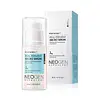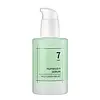What's inside
What's inside
 Key Ingredients
Key Ingredients

 Benefits
Benefits

 Concerns
Concerns

 Ingredients Side-by-side
Ingredients Side-by-side

Bifida Ferment Lysate
Skin ConditioningSaccharomyces Ferment Filtrate
HumectantBetula Alba Juice
AstringentButylene Glycol
HumectantRice Ferment Filtrate
Skin ConditioningGlycerin
HumectantCetyl Ethylhexanoate
EmollientCaprylic/Capric Triglyceride
MaskingAspergillus Ferment
Skin ConditioningDimethicone
EmollientCyclopentasiloxane
EmollientNiacinamide
SmoothingCyclohexasiloxane
EmollientPolyacrylate-13
Water
Skin ConditioningPanthenol
Skin ConditioningDimethicone/Vinyl Dimethicone Crosspolymer
Skin ConditioningPolyisobutene
PEG-7 Glyceryl Cocoate
EmulsifyingCamellia Sinensis Leaf Extract
AntimicrobialCetearyl Olivate
Sorbitan Olivate
EmulsifyingEthylhexylglycerin
Skin ConditioningPolysorbate 20
EmulsifyingSorbitan Isostearate
EmulsifyingLactobacillus
Skin ConditioningXanthan Gum
EmulsifyingSodium Polyacrylate
AbsorbentCaprylyl Glycol
EmollientAdenosine
Skin ConditioningSodium Hyaluronate
HumectantTropolone
Skin ConditioningCentella Asiatica Extract
CleansingPichia/Resveratrol Ferment Extract
Skin Conditioning1,2-Hexanediol
Skin ConditioningHydrolyzed Collagen
EmollientGlutathione
Ascorbic Acid
AntioxidantUbiquinone
AntioxidantThioctic Acid
AntioxidantTocopherol
AntioxidantPhenoxyethanol
PreservativeDisodium EDTA
Bifida Ferment Lysate, Saccharomyces Ferment Filtrate, Betula Alba Juice, Butylene Glycol, Rice Ferment Filtrate, Glycerin, Cetyl Ethylhexanoate, Caprylic/Capric Triglyceride, Aspergillus Ferment, Dimethicone, Cyclopentasiloxane, Niacinamide, Cyclohexasiloxane, Polyacrylate-13, Water, Panthenol, Dimethicone/Vinyl Dimethicone Crosspolymer, Polyisobutene, PEG-7 Glyceryl Cocoate, Camellia Sinensis Leaf Extract, Cetearyl Olivate, Sorbitan Olivate, Ethylhexylglycerin, Polysorbate 20, Sorbitan Isostearate, Lactobacillus, Xanthan Gum, Sodium Polyacrylate, Caprylyl Glycol, Adenosine, Sodium Hyaluronate, Tropolone, Centella Asiatica Extract, Pichia/Resveratrol Ferment Extract, 1,2-Hexanediol, Hydrolyzed Collagen, Glutathione, Ascorbic Acid, Ubiquinone, Thioctic Acid, Tocopherol, Phenoxyethanol, Disodium EDTA
Morinda Citrifolia Extract
AstringentButylene Glycol
HumectantPropanediol
Solvent1,2-Hexanediol
Skin ConditioningGlycerin
HumectantCentella Asiatica Extract
CleansingHouttuynia Cordata Extract
Skin ConditioningArtemisia Princeps Leaf Extract
Skin ConditioningPaeonia Suffruticosa Root Extract
Skin ProtectingLeonurus Sibiricus Extract
Skin ConditioningNelumbo Nucifera Leaf Extract
Skin ConditioningMelilotus Officinalis Extract
AstringentTremella Fuciformis Extract
HumectantLentinus Edodes Extract
Skin ConditioningPhyllostachys Nigra Leaf Extract
Skin ConditioningSaussurea Involucrata Extract
HumectantCorchorus Olitorius Leaf Extract
Skin ConditioningIlex Paraguariensis Leaf Extract
PerfumingMalva Sylvestris Flower Extract
Skin ConditioningLaminaria Japonica Extract
Skin ProtectingRosa Damascena Flower Extract
MaskingChrysanthemum Indicum Flower Extract
Skin ConditioningSolanum Melongena Fruit Extract
Skin ConditioningMelia Azadirachta Leaf Extract
Skin ConditioningScutellaria Baicalensis Root Extract
AstringentPolygonum Cuspidatum Root Extract
AntioxidantGlycyrrhiza Glabra Root Extract
BleachingCamellia Sinensis Leaf Extract
AntimicrobialMelia Azadirachta Flower Extract
Skin ConditioningHamamelis Virginiana Extract
AntiseborrhoeicChamomilla Recutita Flower Extract
MaskingRosmarinus Officinalis Leaf Extract
AntimicrobialHydrolyzed Jojoba Protein
Skin ConditioningAloe Barbadensis Leaf Extract
EmollientMelaleuca Alternifolia Leaf Water
AntimicrobialSodium Hyaluronate
HumectantButyrospermum Parkii Butter
Skin ConditioningAllantoin
Skin ConditioningCaprylic/Capric Triglyceride
MaskingAsiaticoside
AntioxidantMadecassic Acid
Skin ConditioningAsiatic Acid
Skin ConditioningCeramide NP
Skin ConditioningGlyceryl Polymethacrylate
Ammonium Acryloyldimethyltaurate/Vp Copolymer
Hydrogenated Lecithin
EmulsifyingGlyceryl Stearate
EmollientPyridoxine Hcl
Skin ConditioningPhospholipids
Skin ConditioningCholesterol
EmollientCalcium Pantothenate
Arachidyl Glucoside
EmulsifyingSilica
AbrasiveStearic Acid
CleansingMaltodextrin
AbsorbentTromethamine
BufferingCarbomer
Emulsion StabilisingWater
Skin ConditioningEthylhexylglycerin
Skin ConditioningDisodium EDTA
Alcohol Denat.
AntimicrobialMorinda Citrifolia Extract, Butylene Glycol, Propanediol, 1,2-Hexanediol, Glycerin, Centella Asiatica Extract, Houttuynia Cordata Extract, Artemisia Princeps Leaf Extract, Paeonia Suffruticosa Root Extract, Leonurus Sibiricus Extract, Nelumbo Nucifera Leaf Extract, Melilotus Officinalis Extract, Tremella Fuciformis Extract, Lentinus Edodes Extract, Phyllostachys Nigra Leaf Extract, Saussurea Involucrata Extract, Corchorus Olitorius Leaf Extract, Ilex Paraguariensis Leaf Extract, Malva Sylvestris Flower Extract, Laminaria Japonica Extract, Rosa Damascena Flower Extract, Chrysanthemum Indicum Flower Extract, Solanum Melongena Fruit Extract, Melia Azadirachta Leaf Extract, Scutellaria Baicalensis Root Extract, Polygonum Cuspidatum Root Extract, Glycyrrhiza Glabra Root Extract, Camellia Sinensis Leaf Extract, Melia Azadirachta Flower Extract, Hamamelis Virginiana Extract, Chamomilla Recutita Flower Extract, Rosmarinus Officinalis Leaf Extract, Hydrolyzed Jojoba Protein, Aloe Barbadensis Leaf Extract, Melaleuca Alternifolia Leaf Water, Sodium Hyaluronate, Butyrospermum Parkii Butter, Allantoin, Caprylic/Capric Triglyceride, Asiaticoside, Madecassic Acid, Asiatic Acid, Ceramide NP, Glyceryl Polymethacrylate, Ammonium Acryloyldimethyltaurate/Vp Copolymer, Hydrogenated Lecithin, Glyceryl Stearate, Pyridoxine Hcl, Phospholipids, Cholesterol, Calcium Pantothenate, Arachidyl Glucoside, Silica, Stearic Acid, Maltodextrin, Tromethamine, Carbomer, Water, Ethylhexylglycerin, Disodium EDTA, Alcohol Denat.
 Reviews
Reviews

Ingredients Explained
These ingredients are found in both products.
Ingredients higher up in an ingredient list are typically present in a larger amount.
1,2-Hexanediol is a synthetic liquid and another multi-functional powerhouse.
It is a:
- Humectant, drawing moisture into the skin
- Emollient, helping to soften skin
- Solvent, dispersing and stabilizing formulas
- Preservative booster, enhancing the antimicrobial activity of other preservatives
Butylene Glycol (or BG) is used within cosmetic products for a few different reasons:
Overall, Butylene Glycol is a safe and well-rounded ingredient that works well with other ingredients.
Though this ingredient works well with most skin types, some people with sensitive skin may experience a reaction such as allergic rashes, closed comedones, or itchiness.
Learn more about Butylene GlycolCamellia Sinensis Leaf Extract is derived from the leaves of the tea plant. Black tea, green tea, and oolong tea are all harvested from this plant.
This ingredient has many skin benefits:
This ingredient contains polyphenols, a strong antioxidant. Antioxidants help fight off molecules that damage skin cells.
On top of that, the antioxidants in green tea neutralize free-radicals from the sun. This gives the skin some extra UV protection, but should not replace sunscreen.
Many components of tea have anti-inflammatory properties.
Polyphenols and L-theanine help soothe the skin and reduce irritation. The caffeine in Camellia Sinensis Leaf Extract helps calm inflamed blood vessels.
Other compounds found in tea include: Vitamin Bs, linoleic acid, magnesium, calcium, iron, and zinc.
Research has shown both drinking Camellia Sinensis Leaf Tea and applying it to the skin can help boost skin elasticity and hydration. Studies also show using tea extract may reduce sebum, or oil, production.
Learn more about Camellia Sinensis Leaf ExtractThis ingredient is an emollient, solvent, and texture enhancer. It is considered a skin-softener by helping the skin prevent moisture loss.
It helps thicken a product's formula and makes it easier to spread by dissolving clumping compounds.
Caprylic Triglyceride is made by combining glycerin with coconut oil, forming a clear liquid.
While there is an assumption Caprylic Triglyceride can clog pores due to it being derived from coconut oil, there is no research supporting this.
Learn more about Caprylic/Capric TriglycerideCentella Asiatica Extract (Centella) is derived from an herb native to Southeast Asia. It is famous for its anti-inflammatory and soothing properties.
Centella is rich in antioxidants and amino acids, such as Madecassic Acid and Asiaticoside.
Studies show the compounds in centella help with:
The combination of all these properties makes centella effective at soothing, hydrating, and protecting the skin.
Other great components of centella include Vitamin A, vitamin C, several B vitamins, and Asiatic Acid.
Fun fact: Centella has been used as a medicine and in food for many centuries. As a medicine, it is used to treat burns, scratches, and wounds.
Learn more about Centella Asiatica ExtractDisodium EDTA plays a role in making products more stable by aiding other preservatives.
It is a chelating agent, meaning it neutralizes metal ions that may be found in a product.
Disodium EDTA is a salt of edetic acid and is found to be safe in cosmetic ingredients.
Learn more about Disodium EDTAEthylhexylglycerin (we can't pronounce this either) is commonly used as a preservative and skin softener. It is derived from glyceryl.
You might see Ethylhexylglycerin often paired with other preservatives such as phenoxyethanol. Ethylhexylglycerin has been found to increase the effectiveness of these other preservatives.
Glycerin is already naturally found in your skin. It helps moisturize and protect your skin.
A study from 2016 found glycerin to be more effective as a humectant than AHAs and hyaluronic acid.
As a humectant, it helps the skin stay hydrated by pulling moisture to your skin. The low molecular weight of glycerin allows it to pull moisture into the deeper layers of your skin.
Hydrated skin improves your skin barrier; Your skin barrier helps protect against irritants and bacteria.
Glycerin has also been found to have antimicrobial and antiviral properties. Due to these properties, glycerin is often used in wound and burn treatments.
In cosmetics, glycerin is usually derived from plants such as soybean or palm. However, it can also be sourced from animals, such as tallow or animal fat.
This ingredient is organic, colorless, odorless, and non-toxic.
Glycerin is the name for this ingredient in American English. British English uses Glycerol/Glycerine.
Learn more about GlycerinSodium Hyaluronate is hyaluronic acid's salt form. It is commonly derived from the sodium salt of hyaluronic acid.
Like hyaluronic acid, it is great at holding water and acts as a humectant. This makes it a great skin hydrating ingredient.
Sodium Hyaluronate is naturally occurring in our bodies and is mostly found in eye fluid and joints.
These are some other common types of Hyaluronic Acid:
Learn more about Sodium HyaluronateWater. It's the most common cosmetic ingredient of all. You'll usually see it at the top of ingredient lists, meaning that it makes up the largest part of the product.
So why is it so popular? Water most often acts as a solvent - this means that it helps dissolve other ingredients into the formulation.
You'll also recognize water as that liquid we all need to stay alive. If you see this, drink a glass of water. Stay hydrated!
Learn more about Water